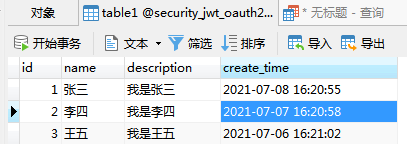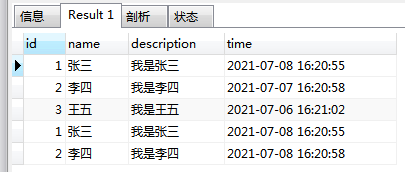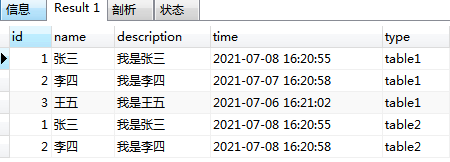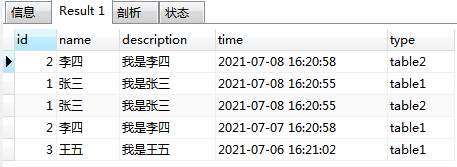MYSQL使用Union將兩張表的數(shù)據(jù)合并顯示
union:用于連接兩個(gè)以上的 SELECT 語(yǔ)句的結(jié)果組合到一個(gè)結(jié)果集合中。多個(gè) SELECT 語(yǔ)句會(huì)刪除重復(fù)的數(shù)據(jù)。
使用union操作符會(huì)將多張表中相同的數(shù)據(jù)取值一次,如果想將表1和表2中的值完整的顯示出來,可以使用union all。
演示小伙伴們自行創(chuàng)建一下表。
表1數(shù)據(jù)如下:

表2數(shù)據(jù)如下:

OK,表數(shù)據(jù)已經(jīng)創(chuàng)建完成,一共五條數(shù)據(jù),接下來我們?nèi)タ匆豢磚nion 和 union all 的使用。
使用union 看一下效果:
select t1.id id, t1.name name, t1.description description,t1.create_time time from table1 t1UNIONselect t2.id id, t2.name name, t2.description description,t2.create_date time from table2 t2

我們可以看到使用union只會(huì)查出來四條數(shù)據(jù)。其中兩條是相同的數(shù)據(jù),則顯示一條。
使用union all 看一下效果:
select t1.id id, t1.name name, t1.description description,t1.create_time time from table1 t1UNION ALLselect t2.id id, t2.name name, t2.description description,t2.create_date time from table2 t2

使用union all查出5條數(shù)據(jù),ps:相同的數(shù)據(jù)也會(huì)查詢出來。
拓展:為了區(qū)分哪張表中的數(shù)據(jù),我們可以這樣做
select t1.id id, t1.name name, t1.description description,t1.create_time time,’table1’ type from table1 t1UNION ALLselect t2.id id, t2.name name, t2.description description,t2.create_date time,’table2’ type from table2 t2

將兩張表中的數(shù)據(jù)按時(shí)間排序
select t3.* from (select t1.id id, t1.name name, t1.description description,t1.create_time time,’table1’ type from table1 t1UNION ALLselect t2.id id, t2.name name, t2.description description,t2.create_date time,’table2’ type from table2 t2) t3 order by t3.time desc

到此這篇關(guān)于MYSQL使用Union將兩張表的數(shù)據(jù)合并顯示的文章就介紹到這了,更多相關(guān)mysql數(shù)據(jù)合并顯示內(nèi)容請(qǐng)搜索好吧啦網(wǎng)以前的文章或繼續(xù)瀏覽下面的相關(guān)文章希望大家以后多多支持好吧啦網(wǎng)!
相關(guān)文章:
1. Mybatis常見注解有哪些(總結(jié))2. mysql利用mysqlbinlog命令恢復(fù)誤刪除數(shù)據(jù)的實(shí)現(xiàn)3. SQL Server 2000數(shù)據(jù)庫(kù)崩潰后的補(bǔ)救措施4. PyCharm MySQL可視化Database配置過程圖解5. ORACLE中常用的幾種正則表達(dá)式小結(jié)6. 詳解MySQL批量入庫(kù)的幾種方式7. MySQL 語(yǔ)句大全:創(chuàng)建、授權(quán)、查詢、修改8. 掌握SQL Server實(shí)戰(zhàn)教程之SQL Server的安裝指南9. 詳解MySQL中事務(wù)的持久性實(shí)現(xiàn)原理10. MySQL 性能、監(jiān)控與災(zāi)難恢復(fù)

 網(wǎng)公網(wǎng)安備
網(wǎng)公網(wǎng)安備